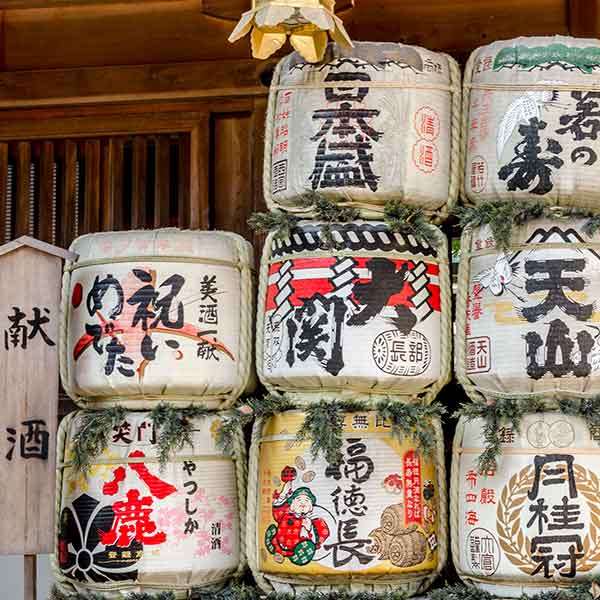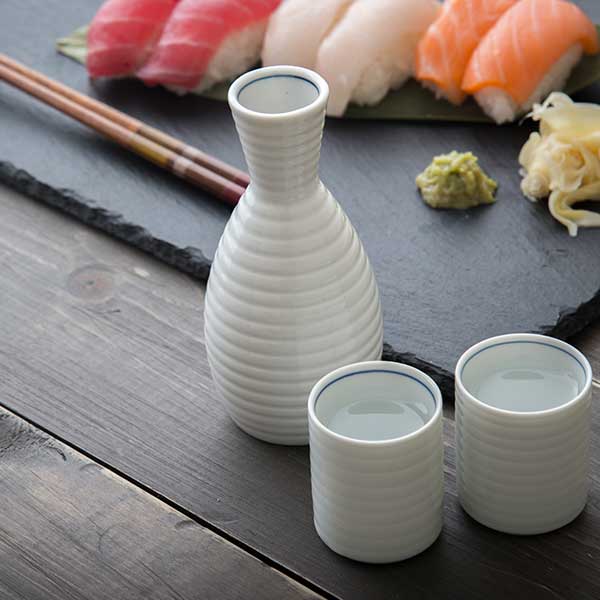At first glance, learning the ins and outs of sake might seem like a daunting task. Fortunately, we're here to break it down to basics. You'll know your junmai from your nigori in no time and finally learn the proper way to serve sake.
Sake is usually described as Japanese rice wine, but in fact, it's a lot closer to beer in terms of how it's produced. As with grapes, there are specific varieties of rice used to make sake and most of this sake rice isn't stuff you'd want to eat. Step one is polishing this rice to remove the bran or the outer layer found on rice grains. This leaves brewers with the starchy “heart” of the rice, which is perfect for fermenting. After polishing, the rice is soaked in water. The water quality is nearly as important as the rice itself, so only high-quality water (which often contains minerals) is used. From here, the rice is inoculated with a special mold, called koji which kicks off fermentation. It continues over several days, during which more rice and water are added to the koji inoculated rice then yeast is added to start alcoholic fermentation. The sake fermentation process is known as multiple parallel fermentation. Once the process has finished, the sake will usually be filtered, pasteurized, and finally matured for several months before bottling.

The Styles of Sake
There are many styles of sake that you're likely to encounter as you begin to explore this lovely drink. Here are the terms you need to know to decipher a sake label.
- Junmai – sake brewed with rice, water, and koji.
- Ginjo – sake made with up to 60% unpolished rice grain.
- Daiginjo – sake made with rice polished up to 50%.
- Honjozo – brewer's alcohol is added.
- Nigori – unfiltered or 'cloudy' sake.
- Genshu – undiluted sake, usually about 20-22% vs a more standard 15-16%.
- Nama – unpasteurized sake.
There are other terms, but the ones we've listed above represent the more common ones you'll see.
Dry or Sweet
Sake can be either dry (not sweet) or sweet. Realistically, most sake tends towards the dry, but if you turn to the back label of a bottle, there's a way to know for sure. The Nihonshu-do or Sake Value Meter you'll find there refers to the sweetness level of the sake bottle in your hand. 0 is considered neutral, with numbers in the negatives, for example -4, are sweet, while positive numbers indicate a dry style. A sweeter sake can be used to offset spice or salt, or to compliment sweetness in a dish. Koshu, aged sake, is fairly uncommon on the market, but its sweetness and richness make it magical with caramel or dark chocolate. One other style to keep your eye open for is sparkling sake. It has a milder taste and is a terrific gateway to the world of sake.

Pairs Well with Food
One of the reasons sake is such a great beverage with food is that virtually all sake has an umami characteristic. This is that savory flavor you find in foods like meats, mushrooms, soy sauce, and fish. Add in the sweet or dry factor, and you've got an all-around winner. The beauty of the many styles in which sake is produced means you can enjoy it with everything from beef to pork, fruity desserts, and of course, sushi and other classic Japanese dishes. If you're thinking of serving sake with meats, look for tarusake, or oak aged sake. The flavor oak helps it stand up to meat dishes and even hard, mature cheeses.
Serving Sake
So what about serving? Most sake is best served slightly chilled or at a cool room temperature. This is especially true for high-quality premium sake. If you prefer your sake hot, aim for about 100 degrees F, or warm but not too hot. Excessive heat masks the more delicate flavors of sake and will limit your ability to pick out the nuances in your glass.
There's much, much more to sake than the ever-present hot swill found at the all you can eat sushi buffet. The cheap stuff is utterly forgettable while quality sake is a thing of beauty. Do yourself a favor and try sake today.